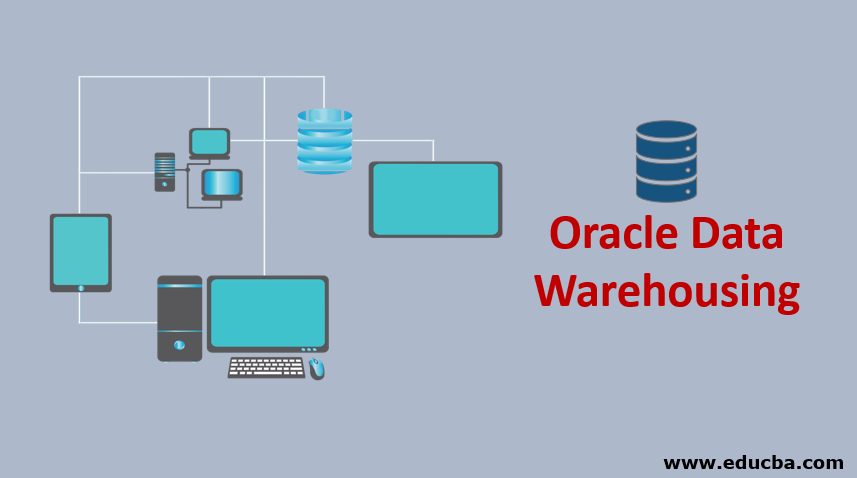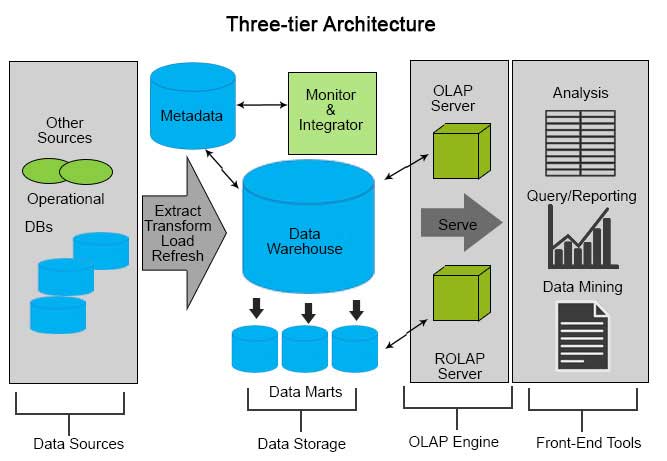Updated March 22, 2023
Introduction to Oracle Data Warehousing
Oracle Data Warehousing is the concept of storing and processing business data through the Oracle database system for business intelligence. Oracle Data warehousing architecture is of several types, such as single-tier, two tiers, and three-tier architecture. Oracle domain being a popular database vendor, provides industry-standard database services for data warehousing implementations. It follows specific characteristics like being subject-oriented for the business, Integrated with various systems, nonvolatile and time-variant. Oracle supports data quality, efficient data processing, and metadata management features for data warehousing solutions. Oracle data warehousing helps businesses with data-driven decision-making processes. Oracle supports various ETL tools for data warehousing.
Precisely, Data Warehousing includes :
- Accumulating historical records from different data sources.
- Inspecting and analyzing past business records.
- Derive insights and required information to drive business needs and motives.
Thus mostly, the operations are read-oriented rather than direct manipulation of datasets. Oracle data warehousing is a fully optimized, cloud-based, comprehensive, and reliable database conception of Oracle database. It is primarily built to experience efficient and flexible database operations which makes it deliver market-leading performance.
Characteristics of Data Warehousing
William H. Inmon, an American computer scientist, refers to characteristics of Data warehousing as :
- Subject-Oriented: A data warehouse is primarily plotted to analyze data and derive insights. We can custom build warehouses on specific departments in a firm, which in turn can deduce leaderboard performers, target customers, etc.
- Integrated: Data that is manipulated is frequently fetched from different sources. In such circumstances, data should prevail consistently preventing conflicts. Such a trait acquired is integrity.
- Non Volatile: When data is yielded into warehousing, it cannot be manipulated or modified. Since analysis is done on the data that has occurred.
- Time-Variant: To derive trends and regression on historical data, the analyst requires a huge amount of data.
The architecture of Oracle Data Warehousing
In general, Oracle data warehousing architecture can be broadly categorized as:
1. Single-Tier Architecture
The primary goal is to reduce data storage to a significant extent, thus removing redundancy. But in practice, it is very less used around.
2. Two-Tier Architecture
A discrete layer of physically available data sources and data warehouses. Comparatively, the architecture is not extensible and also faces connectivity limitations.
3. Three-Tier Architecture
The famous architecture consists of the Bottom, Middle, and Top Tier.
- Bottom Tier: Database vests in this layer which is largely relational database systems. Data resources are collected and manipulated using various back-end applications and fed into the database.
- Middle Tier: Abstracted layered view of the database, which acts as an intermediate between user and database. Oracle supports a powerful OLAP which is implemented in the mid-tier providing secure, scalable analytic measures in the system.
- Top Tier: The front-end layer fetches the data from the database and presents it to the client. It can be any of the Oracle-based querying tools like SQLPlus, SQL developer.
Now we will move forward exploring the details of the overall architecture. Refer to the below image:
- Primarily, the central system, i.e. Oracle data warehouse, consists of Raw data, metadata, and Summary data.
- Raw data are the actual payload of the regular OLTP stored, along with which metadata defines the data present within.
- On the other hand, Summary data holds all redundant, expensive, and long-running operations, which is also called a Materialized view.
- Feeding the right quality data source is more important, which in turn influences the quality and maintenance of data warehousing in the long term.
Data Sources
- In larger enterprises, data are often fetched from different feeds.
- It can be anywhere, ranging from legacy data, external sources, vertical applications.
Staging Area
- The operational data are supposed to be treated and cleaned before being pushed into data warehousing.
- The staging area takes care of this process, which is again can be run programmatically.
- The staging area is responsible for consolidating and processing unstructured data from various data sources.
- The significance of the staging area can be realized when handling enterprise-level warehousing. Data should be coming from collectively in an unstructured format, processed, and consolidated before being fed into the warehouse.
Data Marts
- Apart from handling data sources, an enterprise firm often would be required to customize the architecture scope to various groups.
- Data marts serve such a purpose, where the system depending upon different departments like marketing, inventory is separated purposedly for destined usage. Data marts define the accessibility scope of users and user groups and manage preventive ways.
- For example, the Reporting team would access the Sales data and process dashboard for business, whereas Sales uses data from the analytics team to drive business decisions. Such consolidation and scope definition are declared in data marts.
- Moreover, data marts can be usually co-located with the Oracle data warehouse system or sometimes can be built as separate systems aiding scalability.
Advantages
- Comparatively, the Oracle warehouse is considered to be simple and easily configurable if the objectives and sources are clear.
- It primarily aims at improvising decision-making in business.
- Increased productivity and effective operation costs.
- Supports in transforming large raw data into valuable insights.
- The integrity of data can be guaranteed with prompt quality.
Disadvantages
With all the praises aside, Oracle data warehousing do have certain cons, as explained below:
- Security Concerns: Data security can be precisely accounted for, guarantee only as good as the vendor resource. Also, if an in-house implementation ensures trusted accessibility scope among different streams in a firm can be difficult.
- Data Flexibility: Often, warehouses tend to hold static data and are subject to serious query structures.
- Cost/Benefit Ratio: Maintenance and expanding IT man-hours is a huge factor in the implementation of Oracle Data warehousing.
Quality Management in Oracle Data Warehousing
- Supports end-to-end quality solutions.
- Tracks metadata and summary of the repository.
- Depending on the needs, it can spawn mapping for data corrections.
Data warehousing roles in a firm can specifically be categorized as different job titles ranging from Data miner, Data warehousing consultant/developer to architect. IT industry is constantly witnessing the rapid growth of Data warehousing specializations in business intelligence technologies.
Recommended Articles
This is a guide to Oracle Data Warehousing. Here we discuss the architecture, characteristics, advantages, and disadvantages of Oracle data warehousing. You can also go through our other suggested articles –


